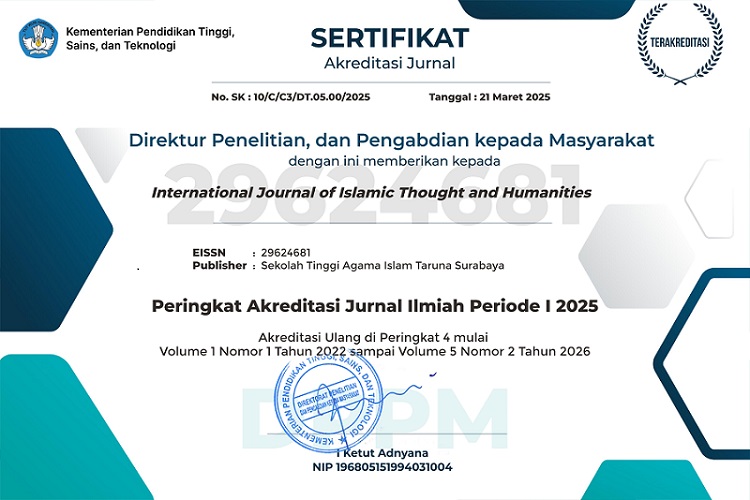Business Resilience of the Muslim Merchants through of Social Capital
DOI:
https://doi.org/10.54298/ijith.v1i2.71Keywords:
social capital, business resilience, amanah, ukhuwah Islamiyyah, Ta’awunAbstract
This study aims to determine the portrait of traditional markets that survive in the era of modern trade competition. There are three problems in this study: business resilience strategies, elements that make up social capital, and business resilience through merchants’s social capital. The research setting is the Soponyono market, which is managed by Masjid Tholabuddin Foundation. The approach in this research is phenomenology approach. Data are collected by snowball sampling technique to Muslim merchants as informants, then, are analyzed through by interactive analysis (qualitative approach). The results of the study reveal that the purpose of the muslim merchants to stay in business, is to seek halal income without worrying about modern trade competition. They practice active, passive, and networking strategies. Of the three, network strategy is considered to play an important role in business resilience. Network strategies are formed in three elements of social capital, namely: mutual trust, social networks, and reciprocity. The theory for examining this study, are Mark Granovetter's about socio-economic attachment theory, Fukuyama about elements of trust, social networks, and reciprocal actions, and Islamic theory, namely: ‘amanah, at-ta’awun, and ukhuwwah Islamiyyah.
Downloads
References
Arifin, S.(2013). Suistanabilitas Bisnis Pedagang Muslim Arab Ampel Surabaya. Disertation - UIN Sunan Kalijaga Yogyakarta).
Arif, M., Saputra, H. E., & Hidayati, N. (2022). The Influence of Service Quality on Consumer Satisfaction at Muslimah Salon and SPA. International Journal of Islamic Thought and Humanities, 1(2 SE-Articles), 132–144. https://doi.org/10.54298/ijith.v1i2.21
Bourdieu, P.(1986). The Forms of Capital. Handbook of Theory and Research for the Sociology of Education, Richardson, J. Westport Connecticut: Greenwood.
Bogdan and Biklen. (1982). Qualitatif Reserarch for Education: An Introduction to Theory and Methods. Boston: Allyn and Bacon.
Coleman, JS.(1988). Social Capital in the Creation of Human Capital. American Journal of Sociology, Vol. 94.
Departemen Pendidikan dan Kebudayaan Republik Indonesia.(1988). Kamus Lengkap Bahasa Indonesia. Jakarta: Departemen Pendidikan dan Kebudayaan Republik Indonesia, 1988.
Fitriyah, RD. Revitalisasi Harmoni Sosial Melalui Modal Sosial Pemimpin Lokal.(2015). Disertation - Universitas Airlangga, 2015).
Fukuyama, F.(1999). The Great Disruption. Boston: The Atlantic Monthly.
Granovetter, M.(1985). Economic Action and Social Structure: The Problem of Embeddedness”. American Journal of Sociology, Vol. 91, No. 3.
Halaby, M. (2022). Riba According to The Al-Quran View: Thematic Tafsir Study About Riba Verses. International Journal of Islamic Thought and Humanities, 1(1 SE-Articles), 17–26. https://doi.org/10.54298/ijith.v1i1.12
Jumiati, E., & Rohmah, I. F. (2022). The Role of Trade Unions/Labor Unions in Islamic Economic Perspective. International Journal of Islamic Thought and Humanities, 1(2 SE-Articles), 91–106. https://doi.org/10.54298/ijith.v1i2.33
Jusmaliani.(2008). Bisnis Berbasis Syariah. Jakarta: Bumi Aksara.
Khotimah, K., Dadang H., and Alipah, N.(2018). Menguak Kesenjangan Antara Pasar Modern Dan Pasar Tradisional. .Jurnal Trunojoyo, Vol. 12 No. 02.
Malik, M.(2014). Islahi Social Capital: A Conceptual Approach Towards Faith-Based Development and Poverty Alleviation. Tokyo: Kyoto Bulletin of Islamic Area Studies.
Miles dan Huberman.(1984)., Qualitative Data Analysis. London: SAGE Publications.
Mustafa, M. (2022). Al Mawardi’s Thoughts on the Welfare State in the 1998-2019 Reform Era in Indonesia. International Journal of Islamic Thought and Humanities, 1(1 SE-Articles), 66–93. https://doi.org/10.54298/ijith.v1i1.39
Neuman, W. Lawrence.(2003). Social Research Methods: Qualitative and Quantitative Approaches. New York: Pearson Education.
Oscar Lewis.(1966). The Culture Of Poverty. Jurnal American, Vol. 215, No. 4.
Putnam, R.(2001). Social Capital: Measurement and Consequences. Isuma: Canadian Journal of Policy Research.
Suharto, E.(2009). Membangun Masyarakat Memberdayakan Masyarakat. Bandung: PT Refika Aditama, 2009.
Tim Kelurahan Kalirungkut.(2018). Laporan Kependudukan Kelurahan Kalirungkut Kecamatan Rungkut Kota Surabaya. Surabaya: Pustaka Rungkut.
Woolcock, M.(1988). Social Capital and Economic Development: Toward Theoretical Synthesis and Policy Framework”. Journal Theory and Society.
Downloads
Published
How to Cite
Issue
Section
License
Copyright (c) 2022 Lia Istifhama

This work is licensed under a Creative Commons Attribution-ShareAlike 4.0 International License.
Authors who publish with this journal agree to the following terms:
- Authors retain copyright and grant the journal right of first publication with the work simultaneously licensed under a Creative Commons Attribution-ShareAlike 4.0 that allows others to share the work with an acknowledgement of the work's authorship and initial publication in this journal.
- Authors are able to enter into separate, additional contractual arrangements for the non-exclusive distribution of the journal's published version of the work (e.g., post it to an institutional repository or publish it in a book), with an acknowledgement of its initial publication in this journal.
- Authors are permitted and encouraged to post their work online (e.g., in institutional repositories or on their website) prior to and during the submission process, as it can lead to productive exchanges, as well as earlier and greater citation of published work (See The Effect of Open Access).


















